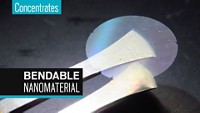Advertisement
Grab your lab coat. Let's get started
Welcome!
Welcome!
Create an account below to get 6 C&EN articles per month, receive newsletters and more - all free.
It seems this is your first time logging in online. Please enter the following information to continue.
As an ACS member you automatically get access to this site. All we need is few more details to create your reading experience.
Not you? Sign in with a different account.
Not you? Sign in with a different account.
ERROR 1
ERROR 1
ERROR 2
ERROR 2
ERROR 2
ERROR 2
ERROR 2
Password and Confirm password must match.
If you have an ACS member number, please enter it here so we can link this account to your membership. (optional)
ERROR 2
ACS values your privacy. By submitting your information, you are gaining access to C&EN and subscribing to our weekly newsletter. We use the information you provide to make your reading experience better, and we will never sell your data to third party members.
Materials
Toward More Reliable Molecular Electronics
Two innovations in fabrication improve properties of molecular junctions
by Bethany Halford
May 9, 2006

A new technique for making molecular junctions could give rise to molecular electronics with consistent, stable, and reliable properties. The simple, potentially low-cost approach ???could pave the way for practical molecular electronics,??? according to the scientists who developed it (Nature 2006, 441, 69).
Electronics researchers have spent years trying to use self-assembled monolayers, or SAMs, as the insulating material in molecular metal-insulator-metal junctions. The electrical properties of these devices, however, tend to be unreliable because of poor electrical contact between the SAM and the metal electrodes. The devices also frequently short out from direct contact between the two metal electrodes.
Bert de Boer, Hylke B. Akkerman, and Paul W. M. Blom of the University of Groningen, in the Netherlands, along with Dago M. de Leeuw of Philips Research were able to overcome these problems by introducing two innovations to the junction fabrication process. First, the group deposits the SAM within lithographically produced cylindrical pores 10???100 µm in diameter. These pores penetrate an insulating plastic film, exposing the gold electrode beneath. The pores protect the SAM from stray currents and from the environment.
The group???s second innovation was to sandwich a layer of conducting polymer between the SAM and the top metal electrode. This layer acts like a cushion and helps to prevent electrical shorts.
The resulting molecular junctions have unprecedented diameters of up to 100 µm. The technique is compatible with standard integrated-circuit fabrication processes, the researchers say, and ???can be scaled up and extended to any molecule and any metal bottom electrode on which an ordered SAM can be formed.???




Join the conversation
Contact the reporter
Submit a Letter to the Editor for publication
Engage with us on Twitter